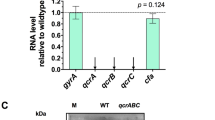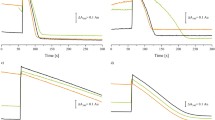Abstract
The respiratory chain of marine and moderately halophilic bacteria requires Na+ for maximum activity, and the site of Na+-dependent activation is located in the NADH-quinone reductase segment. The Na+-dependent NADH-quinone reductase purified from marine bacteriumVibrio alginolyticus is composed of three subunits, α, β, and γ, with apparentM r of 52, 46, and 32kDa, respectively. The FAD-containing β-subunit reacts with NADH and reduces ubiquinone-1 (Q-1) by a one-electron transfer pathway to produce ubisemiquinones. In the presence of the FMN-containing α-subunit and the γ-subunit, Q-1 is converted to ubiquinol-1 without the accumulation of free radicals. The reaction catalyzed by the α-subunit is strictly dependent on Na+ and is strongly inhibited by 2-n-heptyl-4-hydroxyquinoline N-oxide (HQNO), which is tightly coupled to the electrogenic extrusion of Na+. A similar type of Na+-translocating NADH-quinone reductase is widely distributed among marine and moderately halophilic bacteria. The respiratory chain ofV. alginolyticus contains another NADH-quinone reductase which is Na+ independent and has no energy-transducing capacity. These two types of NADH-quinone reductase are quite different with respect to their mode of quinone reduction and their sensitivity toward NADH preincubation.
Similar content being viewed by others
References
Avetisyan, A. V., Dibrov, P. A., Skulachev, V. P., and Sokolov, M. V. (1989).FEBS Lett. 254, 17–21.
Avetisyan, A. V., Bogachev, A. V., Murtasina, R. A., and Skulachev, V. P. (1992).FEBS Lett. 306, 199–202.
Dimroth, P. (1987).Microbiol. Rev. 51, 320–340.
Dimroth, P., and Thomer, A. (1989).Arch. Microbiol. 151, 439–444.
Drapeau, G. R., and MacLeod, R. A. (1963).Biochem. Biophys. Res. Commun. 12, 111–115.
Efiok, B. J. S., and Webster, D. A. (1990).Biochem. Biophys. Res. Commun. 173, 370–375.
Hayashi, M., and Unemoto, T. (1984).Biochim. Biopys. Acta 767, 470–478.
Hayashi, M., and Unemoto, T. (1986).FEBS Lett. 202, 327–330.
Hayashi, M., and Unemoto, T. (1987).Biochim. Biopys. Acta 890, 47–54.
Hayashi, M., Miyoshi, T., Takashina, S., and Unemoto, T. (1989).Biochim. Biophys. Acta 977, 62–69.
Hayashi, M., Miyoshi, T., Sato, M., and Unemoto, T. (1992).Biochim. Biophys. Acta 1099, 145–151.
Kakinuma, Y., and Unemoto, T. (1985).J. Bacteriol. 163, 1293–1295.
Ken-Dror, S., Shneaiderman, R., and Avi-Dor, Y. (1984).Arch. Biochem. Biophys. 229, 640–649.
Ken-Dror, S., Preger, R., and Avi-Dor, Y. (1986a).Arch. Biochem. Biophys. 244, 122–127.
Ken-Dror, S., Lanyi, J. K., Schobert, B., and Avi-Dor, Y. (1986b).Arch. Biochem. Biophys. 244, 766–772.
Kim, Y. J., Mizushima, S., and Tokuda, H. (1991).J. Biochem. 109, 616–621.
Kitada, M., and Horikoshi, K. (1977).J. Bacteriol. 131, 784–788.
Kostyrko, V. A., Semeykina, A. L., Skulachev, V. P., Smirnova, I. A., Vaghina, M. L., and Verkhovskaya, M. L. (1991).Eur. J. Biochem. 198, 527–534.
Krulwich, T. A. (1986).J. Membr. Biol. 89, 113–125.
Kushner, D. J. (1978). InMicrobial Life in Extreme Environment (Kushner, D. J., ed.), Academic Press, London, pp. 317–368.
Lanyi, J. K. (1979).Biochim. Biophys. Acta 559, 377–397.
MacLeod, R. A. (1965).Bacteriol. Rev. 29, 9–23.
Matsushita, K., Ohnishi, T., and Kaback, H. R. (1987).Biochemistry 26, 7732–7737.
Meinhardt, S. W., Wang, D. C., Hon-nami, K., Yagi, T., Oshima, T., and Ohnishi, T. (1990).J. Biol. Chem. 265, 1360–1368.
Miyoshi-Akiyama, T., Hayashi, M., and Unemoto, T. (1993).Biochim. Biophys. Acta,1141, 283–287.
Ohnishi, T., Meinhardt, S. W., Matsushita, K., and Kaback, H. R. (1987). InBioenergetics: Structure and Function of Energy-Transducing Systems (Ozawa, T., and Papa, S., eds.), Japan Sci. Soc. Press, Tokyo, pp. 19–29.
Ragan, C. I. (1987)Curr. Top. Bioenerg. 15, 1–36.
Reichelt, J. L., and Baumann, P. (1974).Arch. Microbiol. 97, 329–345.
Schobert, B., and Lanyi, J. K. (1982).J. Biol. Chem. 257, 10306–10313.
Semeykina, A. L., Skulachev, V. P., Verkhovskaya, M. L., Bulygina, E. S., and Chumakov, K. M. (1989).Eur. J. Biochem. 183, 671–678.
Skulachev, V. P. (1989).FEBS Lett. 250, 106–114.
Sminova, I. A., Vaghina, M. L., and Kostyrko, V. A. (1990).Biochim. Biophys. Acta 1016, 385–391.
Takeda, Y., Fukunaga, N., and Sasaki, S. (1988).Plant Cell Physiol. 29, 207–214.
Tokuda, H. (1983).Biochem. Biophys. Res. Commun. 114, 113–118.
tokuda, H., and Unemoto, T. (1981).Biochem. Biophys. Res. Commun. 102, 265–271.
Tokuda, H., and Unemoto, T. (1982).J. Biol. Chem. 257, 10007–10014.
Tokuda, H., and Unemoto, T. (1984).J. Biol. Chem. 259, 7785–7790.
Tokuda, H., and Kogure, K. (1989).J. Gen. Microbiol. 135, 703–709.
Tokuda, H., Sugasawa, M., and Unemoto, T. (1982).J. Biol. Chem. 257, 788–794.
Tsuchiya, T., and Shinoda, S. (1985).J. Bacteriol. 162, 794–798.
Udagawa, T., Unemoto, T., and Tokuda, H. (1986).J. Biol. Chem. 261, 2616–2622.
Unemoto, T., and Hayashi, M. (1979).J. Biochem. 85, 1461–1467.
Unemoto, T., and Hayashi, M. (1989).J. Bioenerg. Biomembr. 21, 649–662.
Unemoto, T., Hayashi, M., Kozuka, Y., and Hayashi, M. (1974). InEffect of the Ocean Environment on Microbial Activities (Corwell, R. R., and Morita, R. Y., eds.), University Park Press, Baltimore, pp. 46–71.
Unemoto, T., Hayashi, M., and Hayashi, M. (1977).J. Biochem. 82, 1389–1395.
Unemoto, T., Tokuda, H., and Hayashi, M. (1990). InThe Bacteria, Vol. XII: Bacterial Energetics (Krulwich, T. A., ed.), Academic Press, New York, pp. 33–54.
Unemoto, T., Miyoshi, T., and Hayashi, M. (1992a).FEBS Lett. 306, 51–53.
Unemoto, T., Akagawa, A., Mizugaki, M., and Hayashi, M. (1992b).J. Gen. Microbiol. 138, 1999–2005.
Wong, P. T. S., Thompson, J., and MacLeod, R. A. (1969).J. Biol. Chem. 244, 1016–1025.
Yagi, T. (1991).J. Bionerg. Biomembr. 23, 211–225.
Author information
Authors and Affiliations
Rights and permissions
About this article
Cite this article
Unemoto, T., Hayashi, M. Na+-translocating NADH-quinone reductase of marine and halophilic bacteria. J Bioenerg Biomembr 25, 385–391 (1993). https://doi.org/10.1007/BF00762464
Received:
Accepted:
Issue Date:
DOI: https://doi.org/10.1007/BF00762464




